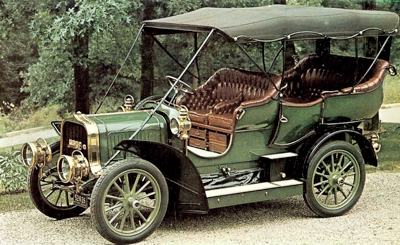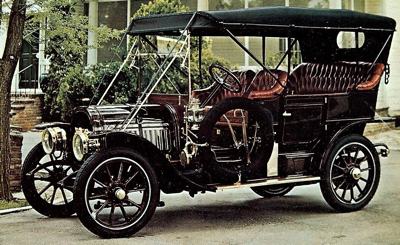Colonel Albert Pope
A number of British cycle manufacturers exhibited their high-wheeled 'ordinary' bicycles at the 1876 Philadelphia Centennial Exposition – and these were to prove extremely popular. The American public placed orders by the thousand. Among the visitors to the exposition was Colonel Albert Pope, a former Civil War officer, who had led his Yankee regiment in the final assault on Petersburg, and now a maker of pistols, who realised that there was a definite future for an American cycle industry.
Columbia Cycles
Pope travelled to Europe to study manufacturing processes at first hand, and to negotiate manufacturing rights, then, on his return home, contracted a deal with the Weed Sewing Machine Company of Hartford, Connecticut, to manufacture cycles under the name 'Columbia'. The combination of Pope's munitions manufacturing know-how, and the sewing-machine company's expertise in the manufacture of small precision parts, proved well-suited to the manufacture of bicycles. Special machine tools were developed, with the goal of making all parts fully interchangeable, to which end the factory worked to tolerances as fine as 1/2000th of an inch, a hitherto unattained standard of accuracy for such work.
Hiram Percy Maxim
In 1892, the Pope Manufacturing Company established its own metallurgical laboratory, the first outside the large steel mills, and there such advances as the development of nickel steel for cycle frames were made. The Pope organisation was one of America's leading manufacturing industries by the time that young Hiram Percy Maxim, son of the inventor of the machine gun, began planning the manufacture of a horseless carriage. Pope had originally conceived the idea as a labour-saving way of propelling his pushbike home from his girlfriend's house. He watched an Otto engine at work, and then experimented himself by exploding petrol in empty cartridge cases to discover what happened when gas was ignited in a cylinder.
It took three years of experiment before, in 1895, Maxim was able to fit a crude petrol engine to his old Columbia tricycle, but his work attracted the attention of Colonel Pope, who was considering establishing it motor carriage department, and asked Maxim to come and work for him. Much to Maxim's disappointment, Pope insisted that he should concentrate on the development of a successful electric carriage. 'You can't get people to sit over an explosion,' growled the colonel. He later relented, believing that the petrol engine might have a limited application as a power unit for commercial carriers' tricycles.
The Pope Petrol Car
Maxim's first Pope petrol car was very crude, relying on the jolting of the vehicle over the unmade roads of Hartford to vaporise the petrol sufficiently - there was no carburetor - and consequently stopped as soon as Maxim tried to run it on asphalted roads. During the next couple of years, five hundred Waverley electrics and fifty petrol vehicles were produced, establishing the Pope organisation as America's first large-scale automobile manufacturers.
George H. Day, vice-president in charge of the horseless carriage activity, was definitely biased towards the electric vehicle, too. One day, watching mechanics dismantle one of Maxim's petrol cars, he queried: 'Maxim, is it necessary to have all those gears in a carriage?' Maxim assured him that gearing was essential when a petrol engine was used. 'And you have to have all that oil?' continued Day. 'Well then, Maxim, let me tell you something. We are on the wrong track. No one will buy a carriage that has to have all that greasy machinery in it.'
 1906 Pope Toledo Type 12.
1906 Pope Toledo Type 12.
 1909 Pope Hartford Type S.
1909 Pope Hartford Type S. |
William C. Whitney
Compared with the booming bicycle business, the automotive side of the Pope empire was a sickly infant. But in April 1899, William C. Whitney, former Secretary of the US Navy, arrived at Hartford. He was representing a group of New York investors who were interested in starting electric cab services in a number of large cities, having already enjoyed some success with the Electric Cab Company of New York. But the group needed 200 cabs immediately, and the only company capable of fulfilling the order was Pope. Whitney immediately took to Maxim's immediate superior, the engineer H. Hayden Eames, who was a former naval lieutenant, and a deal was concluded.
The Columbia & Electric Vehicle Company
A new company was to be set up, with a capital of $3,000,000. The order for electric cabs was increased to 1600, and Eames promised an enlargement of the Pope factory to cope with the extra demand. However, Whitney insisted that there should be no chance of the Columbia & Electric Vehicle Company being sued for infringement of any automotive patents, so Eames asked Pope's patent expert, Herman F. Cuntz, to investigate. Cuntz drew up a list, prominent in which was Selden's 'master patent' of 1895; Eames, Day and Maxim recognised, the Selden patent for the fraud that it was, but Whitney was receptive to the pleadings of the earnest Cuntz, who had found that Selden and his backers were looking for a manufacturer to represent their interests, and eventually, in November 1899, the Columbia & Electric Vehicle Company was awarded a 'definitive licence', which amounted to an assignment of the patent, for $10,000 plus a percentage of royalties paid by other makers.
The Pope-Tribune and Pope Toledo
By 1904, apart from the electrics, the Pope Manufacturing Company was well-established as makers of a wide range of petrol cars. There was the Pope-Tribune a cheap runabout built in Hagerstown, Maryland, from 1904-1907, the Pope-Hartford, a medium-priced car which began as a single cylinder gas buggy of similar type to the contemporary Ford or Cadillac, and the luxurious Pope-Toledo which was built in the former International Motor Car Company factory at Toledo, Ohio. The Pope-Robinson, built at Hyde Park, Massachussetts, was produced by Colonel Pope's cousin Edward, who was cashing in on the family name with a range of luxury cars based on the old Bramwell-Robinson marque.
Anyway, the. Pope empire was quite complex enough without cousin Edward's assistance, and in 19 I 2, three years after the Colonel's death, Pope-Hartford were offering seventeen different models, up to four-cylinder 50 and six-cylinder 60 horsepower models of 6.4 and 7.7 liters. Not to mention the FIAT-Portola, which had a Pope engine in a chain-driven Fiat chassis ... The Pope-Toledo had died in the same year as the Colonel, having been taken over by the Apperson-Toledo Motor Company, the Waverley Electrics were acquired by another company in 1908, which continued manufacture until 1914, the same year in which Pope-Hartford, weakened by years of scattering its fire, eventually collapsed.
